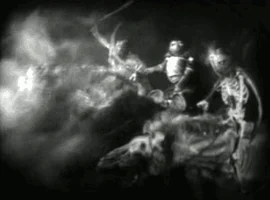
इश्वरहासर्वभूतिनाममहुरुदेरजुनतुषती;
MEANING the Supreme Lord seats himself in the hearts of all
his creatures, setting them into action, deluding them as if they are being so
driven by some mechanical power. Action begets reaction and thus Karma is
anadi, i.e., beginning less and endless. Karma is productive of good and bad;
and one has to enjoy the fruits of the good and bad karma done by him during
this birth or the previous ones. Nobody is free from this vicious circle.
What is that branch of knowledge which enables one to know
the nature and course of his past karma, which shapes the present life? This is
astrology.
What is the scope of astrology? This is already laid down by
Bhattotpala in his Laghu-jataka.
Yadupachitamanyajanmani nrunam shubhashubharn karmanah
pattim;
vyanjayati shastrametat tamasi dravyani deepaiva.
Meaning just as a lamp reveals to an observer the various
things kept in a dark place, so also the shastra throws light on the
accumulated net result of good and bad of past karma which works out in his
present birth. There is a certain amount of freewill to add to his good karma
or to spoil him further.
The indicators of the course of life are the planets who
hold sway over all beings–sentient and non-sentient–in the field of astrology.
What is strength of the planetary cabinet?
The strength is sevenfold.
(Grahaparamkota-yahamukhyassaptaha). There are innumerable planetary orbits but
only seven are important. Trans-Saturnian’s planets are not recognized in Hindu
Astrology. Nevertheless VarahaMihira, in his magnum opus BrihatJataka, has made
a passing reference to Rahu and Ketu. Jaimini has also mentioned
saptanamashtanamva, there- by recognizing Rahu but leaving out Ketu.
This is also true for Ketu’s position is opposite to that of
Rahu. By knowing Rahu’s position we have to add merely 180° to get Ketu’s
position. This method is followed while working out eclipses.
The Rahu and Ketu in Hindu Vedic Astrology
The inclusion of the Moon’s nodes amongst planets is
definitely a matter belonging to post-Vedic age. Although eminent astrologers
disagree in the details about Rahu-Ketu’s effects on the life of human being,
they agree on one point, viz., that these are malefics creating various kinds
of troublesome situations. In the beginning, Saturn and Mars were the only two
known malefic planets. But later on, when certain events could not be explained
by the transits of Saturn and Mars, they were forced to assume the existence of
some other planets which are invisible (adrishta). Saturn was the last planet
visible to the naked eye and used to be called the door-keeper (dwarapala) of
the solar system. Modern astronomy now deals with the movements of three more
planets Herschel, Neptune and Pluto, which are not divisible and are found to
be creating certain peculiar situations. The ancient seers were therefore,
forerunners of the conception of some more planets which are invisible and
appear to have named them as Rahu and Ketu.
An aspect of the Dasa periods of several planets lends a
support to the above view. Rahu, for example, has been allotted 18 years for
its influence, while Ketu has been given only 7 years, Why this variation? This
may have been due to the fact that according to the ancient seers, Rahu and
Ketu were really some invisible planets, having different motions, and were not
the pair of the Moon’s nodes of modern conception.
Rahu is supposed to be a distress-giving planet. He afflicts
a radical with regard to matters governed by the house in which he is situated
at birth. Similarly, he is said to act in accordance with the planet he may be
associated with. While Rahu is the significator of troubles on account of
departed souls, ghosts and snake-poisons, Ketu is said to govern the night, the
time of journey, gambling, gains through immoral sources, and so on. Rahu
sometimes indicates events pertaining to father’s father and Ketu, mother’s
father (sarpenaivapitamahamtushik-hinammatamahamchintayet). Rahu is said to be
very powerful in the 3rd, the 6th and the 11th (trishadekadaseRahuhu) and
create painful events, if situated in the 5th, 7th, and 12th houses.
Standard works on astrology describe at length the nature of
persons born with Rahu in each of the 12 houses. Similarly, the effects of Ketu
are described house-wise. But, when Ketu necessarily occupies the house
opposites to that of Rahu, how could the effects be different? For example,
when Rahu is in the 1st house, Ketu must be in the 7th, or when Rahu is in
the3rd, Ketu is taken to be in the 9th. The astrological works say that one
born with Rahu in the 3rd is very pious, powerful, gets happiness from
brothers, is valorous; one born with Ketu is impious, has a secretive nature
holds pretentious designs, hates people and tends to attain gains through
immoral means. How to account for such pairs of opposite effects? I feel, the
results have been described for Rahu and Ketu, regarding them as actual planets
which are invisible and not as the Moon’s nodes.
“Always ready to bestow on his devotees riches and plenty,
friendly and loving, adorned with sandal paste, flowers and an umbrella–all of
blue colour, armed with a sword and skin, seated south-faced on a throne and
surrounded by all saktis, may the Dark Blue Rahu be pleased.”
“Decked with silk, flowers, garlands, sandal paste and an
umbrella–all of variegated colours and seated in a divine car thou goeth round
the mount Meru. Born of Jaimini’s family under Abhijit star may that
four-armed, deathless, effulgent Ketu seated south- faced on the throne make us
all happy for ever with wealth and abundance."
THESE prayers from the Vedic hymns show clearly that Rahu
and Ketu had been recognized even in those days among the Navagrahas (nine
planets). The Sun and the Moon are said to be Prakasha (shining) grahas; Mars,
Mercury, Jupiter, Venus and Saturn as Tara Grahas while Rahu and Ketu are
styled as Thamograhas. Rahu is worshipped for health and prosperity. Ketu in
spite of his awe-inspiring appearance instills divinity in human beings and
leads them to the path of liberation. These shadow planets visible only at the
time of eclipse are propitiated by mantras and oblations to ward off the
poison-laden rays emanating from the eclipsed Sun and Moon.
These two planets, for reasons not yet known, have not been
dealt with in detail as the other seven planets by any seer or sage of
astrology. From what little guidance they have given us, we have to build up by
indepth research.
RAHU plays a very important role in astrology. The
Westerners do not appear to have shown much interest in the astrological
effects of Rahu. But many Indian astrologers show their competence in
predicting events only by considering the radical and transitory positions of
Rahu.
It is intended to show how there have been different
conceptions about Rahu in different ages, and even by accepting the present-day
conceptions of the Moon’s node as Rahu, there appears to be a need of some
modification.
Dr. Shanker Adawal
Profile: www.connectingmind.com
Research work and articles on Bhrigu Nadi astrology: www.shankerstudy.com
https://www.facebook.com/groups/Astrology.Fan.Club/
Profile: www.connectingmind.com
Research work and articles on Bhrigu Nadi astrology: www.shankerstudy.com
https://www.facebook.com/groups/Astrology.Fan.Club/


































No comments:
Post a Comment